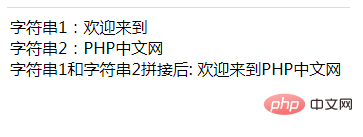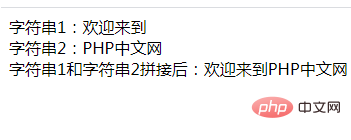What does php dot mean?
In PHP, dot "." means "connection" or "splicing". It is a string connector that can be used to splice two or more strings together to form A new string; the specific syntax format is "$string = $string1.$string2.$string3. ······ .$stringN;". In addition to using "." strings to concatenate strings, there is also the assignment operator ".=" and the syntax "$string1 .= $string2".

The operating environment of this tutorial: windows7 system, PHP8 version, DELL G3 computer
In php, click "." refers to the string concatenation character, which can splice two or more strings into a new string.
The specific syntax format is as follows:
$string = $string1.$string2.$string3. ······ .$stringN;
Example:
<?php
header("Content-type:text/html;charset=utf-8");
$str1="欢迎来到";
$str2="PHP中文网";
$str3=$str1.$str2;
echo "字符串1:".$str1;
echo "<br>字符串2:".$str2;
echo "<br>字符串1和字符串2拼接后:".$str3;
?>Output result:

You can see When we use echo for output, we sometimes need some text prompts. At this time, we can use the string concatenator to splice the text strings and variables surrounded by quotation marks together for output, such as the "echo " character After concatenating string 1 and string 2: ".$str3;".
Note:
When using echo to output a string, you can also use curly brackets
{$str}to embed variables in the string, such as "Text {$str}Text"; If {} is not used, you can also use word segmentation characters to separate variables and text. Word segmentation characters are generally spaces, punctuation marks, etc.
<?php
header("Content-type:text/html;charset=utf-8");
$str1="欢迎来到";
$str2="PHP中文网";
$str3=$str1.$str2;
echo "字符串1:".$str1;
echo "<br>字符串2:$str2";
echo "<br>字符串1和字符串2拼接后: {$str3}";
?>Output result:

Extended knowledge: use assignment operator.=
Except Use the "." operator to concatenate strings, and you can also use the assignment operator ".=" to concatenate strings.
In PHP, you can use the format of "$string1 .= $string2" to concatenate strings. The
.= operator appends the characters on the right to the left. Its syntax is:
$string = string1; $string .= string2; $string .= string3; ······ $string .= stringn;
Let’s take a look at the following example to understand the .= operator.
<?php
header("Content-type:text/html;charset=utf-8");
$str1="欢迎来到";
echo "字符串1:".$str1;
$str2="PHP中文网";
echo "<br>字符串2:".$str2;
$str1.=$str2;
echo "<br>字符串1和字符串2拼接后:".$str1;
?>Output results:

Recommended learning: "PHP Video Tutorial"
The above is the detailed content of What does php dot mean?. For more information, please follow other related articles on the PHP Chinese website!

Hot AI Tools

Undresser.AI Undress
AI-powered app for creating realistic nude photos

AI Clothes Remover
Online AI tool for removing clothes from photos.

Undress AI Tool
Undress images for free

Clothoff.io
AI clothes remover

AI Hentai Generator
Generate AI Hentai for free.

Hot Article

Hot Tools

Notepad++7.3.1
Easy-to-use and free code editor

SublimeText3 Chinese version
Chinese version, very easy to use

Zend Studio 13.0.1
Powerful PHP integrated development environment

Dreamweaver CS6
Visual web development tools

SublimeText3 Mac version
God-level code editing software (SublimeText3)

Hot Topics
 CakePHP Project Configuration
Sep 10, 2024 pm 05:25 PM
CakePHP Project Configuration
Sep 10, 2024 pm 05:25 PM
In this chapter, we will understand the Environment Variables, General Configuration, Database Configuration and Email Configuration in CakePHP.
 PHP 8.4 Installation and Upgrade guide for Ubuntu and Debian
Dec 24, 2024 pm 04:42 PM
PHP 8.4 Installation and Upgrade guide for Ubuntu and Debian
Dec 24, 2024 pm 04:42 PM
PHP 8.4 brings several new features, security improvements, and performance improvements with healthy amounts of feature deprecations and removals. This guide explains how to install PHP 8.4 or upgrade to PHP 8.4 on Ubuntu, Debian, or their derivati
 CakePHP Date and Time
Sep 10, 2024 pm 05:27 PM
CakePHP Date and Time
Sep 10, 2024 pm 05:27 PM
To work with date and time in cakephp4, we are going to make use of the available FrozenTime class.
 CakePHP File upload
Sep 10, 2024 pm 05:27 PM
CakePHP File upload
Sep 10, 2024 pm 05:27 PM
To work on file upload we are going to use the form helper. Here, is an example for file upload.
 CakePHP Routing
Sep 10, 2024 pm 05:25 PM
CakePHP Routing
Sep 10, 2024 pm 05:25 PM
In this chapter, we are going to learn the following topics related to routing ?
 Discuss CakePHP
Sep 10, 2024 pm 05:28 PM
Discuss CakePHP
Sep 10, 2024 pm 05:28 PM
CakePHP is an open-source framework for PHP. It is intended to make developing, deploying and maintaining applications much easier. CakePHP is based on a MVC-like architecture that is both powerful and easy to grasp. Models, Views, and Controllers gu
 CakePHP Working with Database
Sep 10, 2024 pm 05:25 PM
CakePHP Working with Database
Sep 10, 2024 pm 05:25 PM
Working with database in CakePHP is very easy. We will understand the CRUD (Create, Read, Update, Delete) operations in this chapter.
 CakePHP Creating Validators
Sep 10, 2024 pm 05:26 PM
CakePHP Creating Validators
Sep 10, 2024 pm 05:26 PM
Validator can be created by adding the following two lines in the controller.






